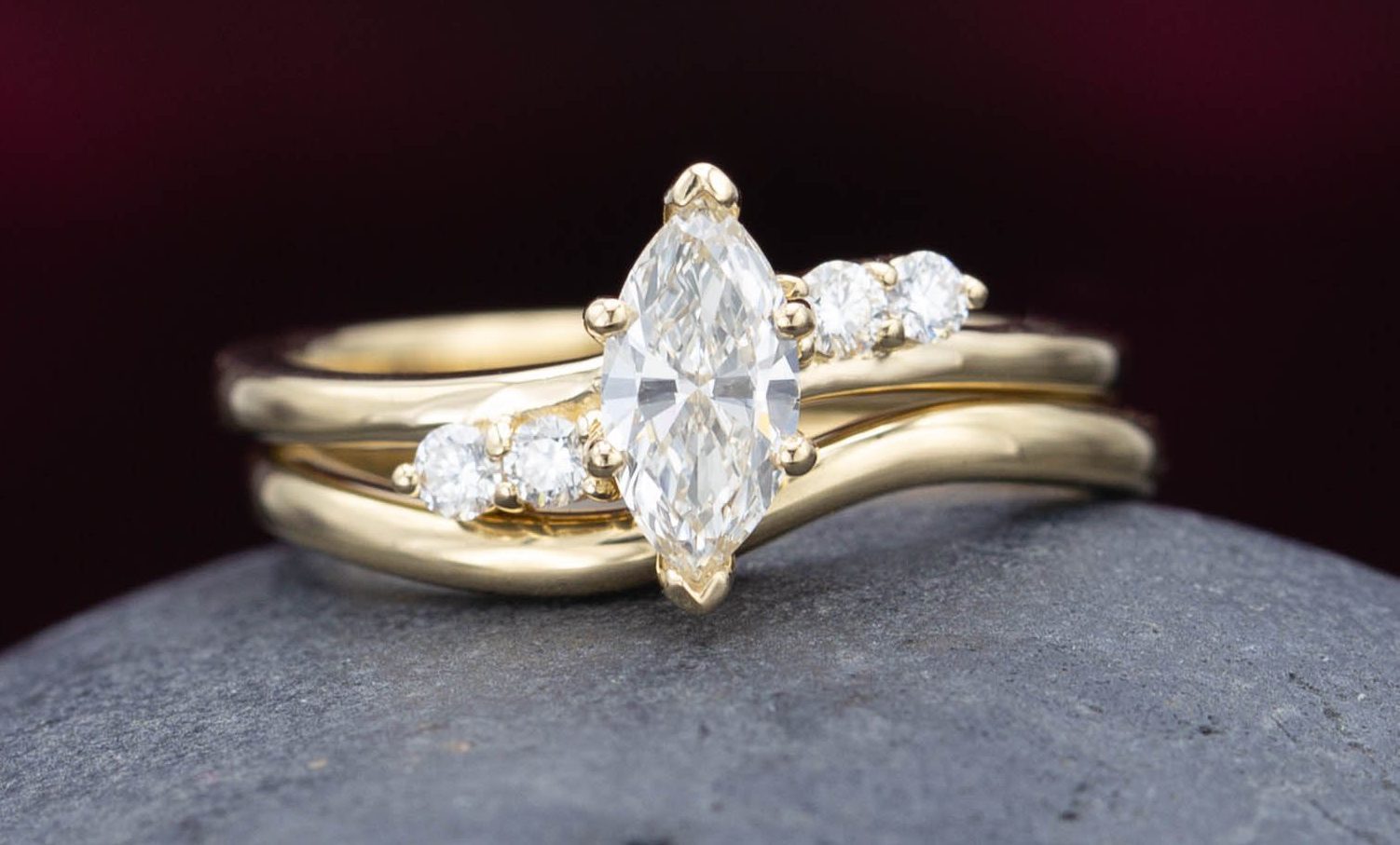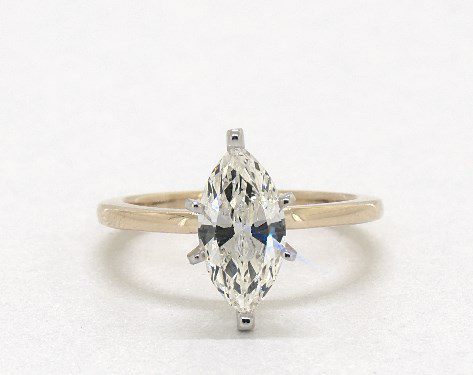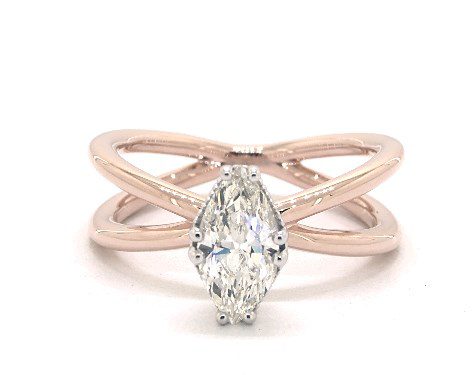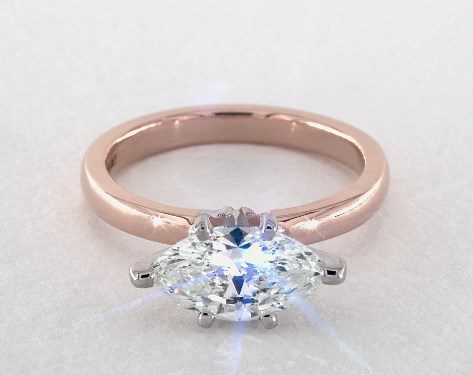Marquise-Cut Diamonds Buying Guide: Vintage & Modern
A beautiful and versatile shape, marquise-cut diamonds are perfect for unique engagement rings. Learn how to pick the stone that’s best for you.
8 Minute Read
at CustomMade
What is a Marquise-Cut Diamond?
Marquise-cut diamonds feature an elongated shape that many refer to as an "eye" or "football" shape. Marquise diamonds vary in shape from gem to gem which makes each one special and unique.
Marquise-Cut Diamonds: Pros and Cons
Before choosing any diamond shape, first and foremost, you must consider the shape itself and whether or not it appeals to you. Marquise-cut diamonds have a unique look — an elongated ellipse with pointed ends. If that's not right for your style, there are still plenty of other diamond shapes you can pick.
Think about the style and type of ring you'd like. A marquise looks great in intricate vintage styles and halo settings but can also work as an eye-catching solitaire. Marquise-shaped diamonds are also great for trendy East-West settings and double band rings.
Images © James Allen. Used with permission.
If a marquise shape fits your style, you'll be happy to know it will offer significant savings when compared to a round diamond of the same carat weight. Marquise-cut diamonds also have a lot of face-up area and appear 15% larger than an equivalent-carat round. Furthermore, the elongated shape makes fingers appear longer and thinner and makes diamonds look absolutely huge. At one carat, most marquise diamonds are over 1 cm long.
However, the pointed ends of a marquise-cut diamond can snag and chip. Make sure these ends are secured and covered by prongs in their setting. The marquise's unique shape can also make it a challenge to find one that's well-cut and symmetrical without a ghastly bowtie region. Finding the perfect marquise shape may take some time, especially if you're searching for larger sizes or have a tight budget.
at CustomMade
Marquise-Cut Diamonds Ideal Cut Quality and Shape
You can't evaluate the cut quality of a marquise diamond the same way you evaluate a round brilliant. In fact, the cut quality of a marquise, like all fancy-shaped diamonds, is largely subjective. You absolutely have to get a good, close-up look at a marquise-cut diamond before you buy.
Shape Appeal
You'll want to choose a diamond with great shape appeal. If a diamond's appearance seems a little off, it's likely due to poor shape or asymmetry.
A marquise shape should have pointed tips. The areas on either side of the tips are called "wings." Make sure that these aren't too flat or bulging. The middle area, called the "belly," should also have a gentle curve, neither flat nor bulging.
Images © James Allen. Used with permission.
Symmetry
Visibly poor symmetry is detrimental to a marquise-cut diamond. To evaluate symmetry, draw an imaginary line down the diamond from tip to tip. Then, see if the tips, wings, and belly appear symmetrical. Next, draw another imaginary line across the center of the belly. Make sure that the diamond is symmetrical in this direction as well.
Asymmetry really stands out in marquise-cut diamonds because of their elongated shape. If you end up with an asymmetrical marquise, you'll notice it.
Note that this "shape symmetry" isn't the same as the "symmetry" on a diamond grading report, which only refers to facet symmetry. A facet symmetry grade of "Good" or better can get you a beautiful marquise-cut diamond.
Marquise-Cut Length-to-Width Ratio
Largely a matter of preference, the length-to-width ratio (L/W) dramatically changes the look of a marquise diamond. Lower ratios make shorter diamonds, and very short diamonds may look chubby. On the other hand, very long diamonds may have poor performance, since cutting a very long marquise without sacrificing brilliance can be difficult.
Most people prefer marquises with L/W from 1.7 to 2.2. Take a look at these stones set in engagement rings to see which L/W ratio you prefer.
Images © James Allen. Used with permission. Click here to compare these diamonds side-by-side.
Marquise-Cut Table and Depth
In order to weed out some poorly cut diamonds, you can limit the table to 53-63% and the total depth percentage to 58-62%. While this won't remove every poor performer, you won't have as many diamonds to sift through.
Marquise-Cut Bowtie Effect
Because of the faceting pattern, every marquise-cut diamond will have a bowtie — a dark band across the center of the stone. However, some will be more prominent than others. Avoid large bowties. Most importantly, remember that a diamond that doesn't show sparkle in the middle of the stone isn't worth your money.
Images © James Allen. Used with permission. Click here to compare these diamonds side-by-side.
Marquise-Cut Clarity
Marquise-cut diamonds have great brilliance and will hide inclusions even with a low clarity grade. For this cut, an eye-clean SI1 diamond will give you the most for your money. Nevertheless, marquise diamonds with inclusions near the sides are preferable to those with inclusions near the center. Large, dark imperfections near the center will likely be eye-visible, but other types of imperfections may not be.
If your budget is tight, try to find an eye-clean SI2 or I1 diamond. The imperfections in many of these diamonds won't be visible to the eye, especially at sizes below two carats.
Marquise-Cut Color
Like other fancy shapes, a marquise-cut diamond will reveal color more easily than a round diamond. Color usually shows most near the tips.
If you're pairing a marquise diamond with white gold or platinum, stick to a color grade of H or better. An H color diamond will appear white and cost less than a higher color grade.
For yellow and rose gold rings, a marquise diamond will still look colorless all the way down to K color. Since the metal will reflect some of its color in the diamond anyway, the slight warmth in a K color diamond will still look white against colored metal.
Marquise Cut Lab Grown Diamonds
Should I Buy a Marquise Cut Lab Grown Diamond?
If you're considering purchasing a Marquise cut lab grown diamond, there are several factors to weigh. Lab grown diamonds offer a conflict-free and eco-friendly alternative to mined diamonds, making them an ethical choice for conscientious buyers.
The Marquise cut, known for its elongated shape and brilliant sparkle, can be an excellent choice for those seeking a unique and elegant look. Lab grown diamonds typically come at a more affordable price point than their natural counterparts, allowing you to get a larger and higher-quality stone for your budget. If you value sustainability, affordability, and an eye-catching appearance, a Marquise cut lab-grown diamond might be the perfect choice for you.
st James Allen
at James Allen
How to Buy a Marquise Cut Lab Grown Diamond
When buying a Marquise cut lab grown diamond, it's crucial to follow a few key steps to ensure a satisfactory purchase. Firstly, educate yourself about lab grown diamonds and their characteristics, so you can make an informed decision. Set a budget and determine the desired carat weight and quality to narrow down your options.
Next, choose a reputable and trustworthy jeweler or online retailer known for selling lab grown diamonds. Examine the diamond's cut, color, clarity, and carat weight to match your preferences. Additionally, request images or videos of the diamond to assess its appearance closely. Online retailers James Allen and Blue Nile both do an excellent job with this.
Lastly, consider the jeweler's return policy and warranty to protect your investment. By following these steps, you can confidently select a stunning Marquise cut lab grown diamond that aligns with your style, budget, and values.
at James Allen
at Blue Nile
Marquise Cut Fancy Colored Diamonds
at CustomMade
Fancy colored diamonds are becoming increasingly popular. They are not just a passing trend. Enhance your jewelry collection with the elegance of a marquise cut colored diamond jewelry piece. The elliptical shape of the marquise cut offers the benefit of elongating the fingers when worn in a ring. Crafting a piece with a colored diamond ensures unparalleled style and sophistication.
By combining the captivating colors of a fancy colored diamond with the charm of the marquise cut, you will unveil a piece that will surely be cherished and admired for years to come. Online retailers CustomMade, Blue Nile and James Allen make finding the perfect fancy colored diamond accessible and uncomplicated.
Where Should I Buy a Marquise-Cut Diamond?
For marquise-cut diamonds, it's essential to see their shape and performance before you buy. If you're shopping online, stick to vendors with closeup videos so you can see what the actual diamonds look like.
Both Blue Nile and James Allen offer high-quality, closeup 360° videos of their diamonds. However, James Allen has a major advantage over Blue Nile. They have many more ring styles to choose from, including plenty of vintage options for marquise diamonds. Still, if you're picky about the shape — if you're looking for a replacement stone for an existing setting, for example — you may prefer to use Blue Nile. Their website lets you filter your searches by L/W, a feature James Allen lacks.
Marquise-Cut Summary
- 1. A marquise looks great in intricate vintage styles, halo settings, as a solitaire, East-West settings or double band rings.
- 2. The elongated shape makes fingers appear longer and thinner and makes the diamond look absolutely huge.
- 3. Be careful! The pointed ends of a marquise-cut diamond can snag and chip.
As an alternative, you could design a completely unique ring with CustomMade. Their experts will help you find the perfect marquise for your tastes and budget and place it in a ring made just for you.
FAQ
1. Are marquise cut diamonds more expensive?
Marquise cut diamonds are less expensive than round cut diamonds of the same carat weight. This is because their shape uses up more of the diamond's rough, allowing gem cutters to make bigger cuts out of the same amount of raw material. They are also less in demand than round cut diamonds, which can fetch a higher price for their popularity.
2. Is marquise a good diamond cut?
Marquise diamonds are a great cut if you are looking for a nontraditional diamond cut with an elongated shape. Marquise cut diamonds are very versatile, and their unique shape makes them perfect in vintage styles and as stunning solitaire gems. Marquise cut diamonds also have a noticeably larger face-up surface area than round cut diamonds, giving you a larger-looking gem for the same carat weight.
3. What is special about a marquise diamond?
Marquise diamonds are special for their unique, elongated shape and the variation of shape from gem to gem. Not all marquise diamonds will look the same, as differing length-to-width ratios can create many different looks and further personalize your gem.
4. Which cut of diamond looks biggest?
Elongated cuts such as marquise, oval, and pear often appear larger than round cut diamonds of the same carat weight because they appear longer on your finger. These cuts also have a larger face-up surface area compared to rounded shapes because they have a more shallow cut, so the diamond's visible size will actually be larger.
Addison Rice
A geologist, environmental engineer and Caltech graduate, Addison’s interest in the mesmerizing and beautiful results of earth’s geological processes began in her elementary school’s environmental club. When she isn’t writing about gems and minerals, Addison spends winters studying ancient climates in Iceland and summers hiking the Colorado Rockies.
Related Articles
Diamond Value, Price, and Jewelry Information
Lab-Grown Diamonds FAQ
Is a Super Ideal Cut Diamond Worth It?
Moissanite vs Diamond: Ultimate Comparison Guide for Engagement Rings
Latest Articles
800 Years of Mogok: A Celebration in Tenuous Times
What is the Average Gemstone Faceting Yield?
Pyroxmangite Value, Price, and Jewelry Information
How to Identify Emerald Simulants and Synthetics
Never Stop Learning
When you join the IGS community, you get trusted diamond & gemstone information when you need it.
Get Gemology Insights
Get started with the International Gem Society’s free guide to gemstone identification. Join our weekly newsletter & get a free copy of the Gem ID Checklist!



